

Physical Characteristics
Border
Collies come in so many shapes and sizes it is difficult to believe that
all these dogs are of the same breed. Different
physical characteristics reflect the different types of sheepdog that have
been bred into Border Collie lines in the distant past.
The illustrations are there to demonstrate many of the variations and do
not directly relate to the text around them.
Coat types 
They can be flat, wiry, curly or rough. There are all combinations of these coat types. The very short, straight coated, smooth dogs can also be called 'Bald Coated' although they are not hairless. Those with very coarse fur can look almost 'Wiry'. Some are heavily feathered on the legs, tail and around the ears and can have large ruffs and very bushy tails. Some have little or no feathering anywhere with fur on tail and ruff flat to the body. |

There are solid colours - Black, White, Chocolate, Blue (actually grey really), Brown, Sable, Red, Liver, Lilac. Etc. There are bi-colours - Black / White, Red / White, Sable / White, Blue / White, Chocolate / White, Liver / White, Chocolate / Sable, Etc. There are Tricolours- Black - White and Brown, Black - White and Red, Black - White and Blue, Black - White and Sable, Black - White and Grey, Black - White and spotted with another colour, Etc. 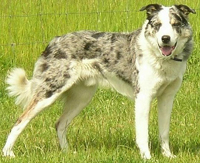
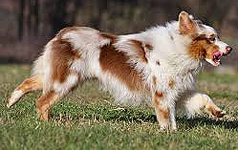
They are the inventions of breeders who are trying to set a new fashion in order to sell more pups at a higher price. Wait for it - Pink, coming soon to your agility club. All combinations are possible with sufficient genetic fiddling but they are all Border Collies, although you have to feel sorry for some of them. The good old fashioned colours are the best. Black, Black and Tan, Black and White, Tricolour, Sable - with variations and the occasional full merle. |
Size 
We have come across some individuals that are so small they could only be defined as 'Miniature' when compared to the average. One we took in was called Mouse - descriptive! On the other hand we have come across giants. We have seen both these extremes and many in between with KC or ISDS pedigrees or without either. |
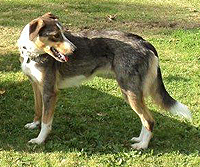
We get long legged - short legged - long backed - short backed - wide shouldered - narrow waisted - wide hips - narrow hips - deep chested - shallow chested - long tailed - short tailed. Registered and unregistered the shape and proportions of a Border Collie varies greatly. There is no uniformity in any aspect of the appearance of the breed. |
Head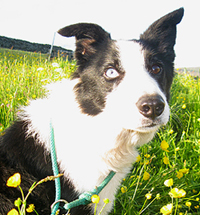
The nose can be long or short, narrow or wide and the stop sloping or sharp. Ears can be tipped or pricked or flat. Eyes can be set wide or narrow and can be many colours although generally both the same. The most common eye colour is brown but there are many variations. A dog can have different colour eyes and in the case of 'wall eye' one eye is one colour and the other blue/grey. In some cases both eyes can be grey or a deep blue. Other Border Collies can have very intensive eyes, deep brown flecked with gold. |
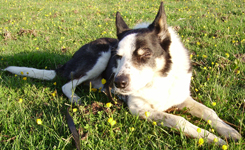
Short to long, Black or black with white tip or varying percentages of Black and White. Tricolour. Tan, Red, Blue, Grey, Sable, with or without white tip or larger percentage of white. On occasions, all white. You get many variations of shape and colour in the Border Collie. |

It is a long, rough coated medium sized black and white dog with white socks, white ruff which completely encircles the neck, a white chest and a white tip to its tail. It is feathered on its legs and tail and we are led to believe this is the norm for the breed. It is certainly pretty to look at and if that is what you want in a dog, it's a good choice. We have re-homed plenty of these and they can be a little dumb. The description "the most intelligent dog" in the world does not apply. |
| It is a bit of spin - the most prolific type of Border Collie is the smooth coated type. |

These have been bred in that way to enable them to be agile and sure footed on steep mountain terrain where a larger dog may lose balance on steep slopes or fall off narrow ledges. There is not actually a Welsh Border Collie breed - there is a Welsh Sheepdog that is said to have some Border Collie in there. |
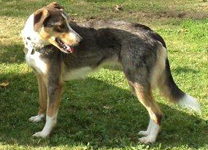
It is not a separate breed, it's just another variation of the same breed - the Border Collie. Another misconception is what is often described as the McNab Border Collie. This is not a Border Collie or a variation of it. It is more correctly known as the McNab Shepherd or McNab Collie or simply as the McNab Dog. It is a herding dog specifically bred to cope with the hot weather of Northern California. Like the Border Collie it comes in many colours and sizes but is a smooth, short to medium coated dog. It originated from a crossing of Scottish Collies with dogs from the Basque region. Border Collie may be in there somewhere as in breeds like the New Zealand Huntaway and the Australian Kelpie - somewhere inside, hiding. |
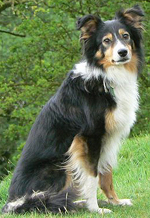
They do not get 'iced up' in bad weather, whereas the longer coated dogs would end up with a coat full of water, snow or ice that would weigh it down and slow it up. Smooth coated dogs are easier to keep clean after a day in the fields but the best known variation is the rough, long coated, medium sized, standard markings, black and white type. You get these in all categories, KC, ISDS and unregistered. This is what most people think of as a Border Collie and they are often surprised to find out that all these other shapes colours and sizes are variations of the same breed. |
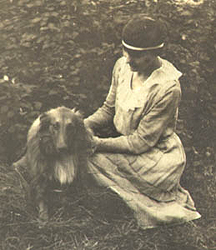 |
|
This historic photo shows a Border Collie from sometime around
1910 to 1920.
According to the caption the dog was Red and White. |
If you are interested in adopting a Border Collie from us,
please do not write to us or email us - we want to speak to you before we start the process.
Please phone us during office hours. Details here.
Calls to our office and mobile will only be answered during our office hours
All content copyright © Border Collie
Rescue 3037504. Charity No 1128983 Charity No SC040796 (Scotland). All
Rights Reserved.
The border collie rescue society is a specialist canine welfare charity based in the uk to help the border collie dog breed and the working sheepdog.
Border Collie Rescue On Line is the official worldwide website of this UK based breed rescue organisation.
RIPA Notice :NO CONSENT IS GIVEN FOR
INTERCEPTION OF PAGE TRANSMISSIONS FOR ANY PAGE ON THIS WEBSITE


















